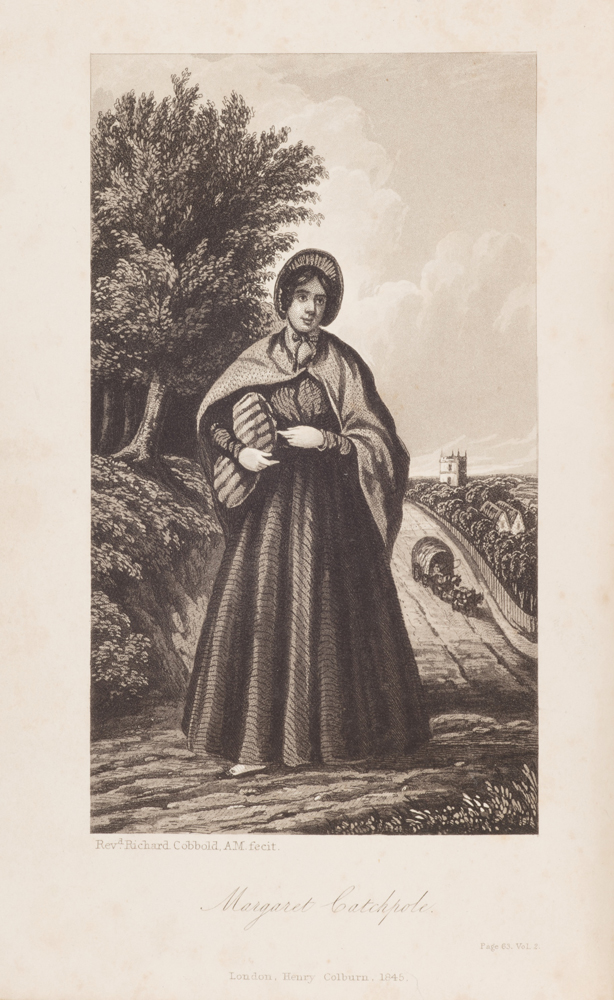About Margaret Catchpole
Margaret Catchpole was a servant, thief and engaging correspondent.
Born in Suffolk, England, Margaret worked as a servant before being convicted of stealing a horse and later of escaping from the Suffolk County Gaol. Transported to New South Wales for life in 1801, she worked as a cook, nurse and midwife.
Margaret’s vivid letters to friends and family in England were the basis for a partly fictional account of her life published posthumously in Richard Cobbold’s The History of Margaret Catchpole, a Suffolk Girl.
Margaret’s writing is an important literary record of Australia’s early convict period. It is also the only written record of the devastating 1806 and 1809 Hawkesbury floods.
Location
Category
Share and save

The early days of Margaret Catchpole
Margaret Catchpole was born in 1762 in Suffolk, England spending her early life on farms. With little formal education, Margaret worked as a servant and later took up duties as cook and nurse for wealthy Ipswich brewer John Cobbold and his wife, Elizabeth. Whilst working for the Cobbolds, Elizabeth taught Margaret how to read and write, and the pair remained good friends throughout their lives.
Criminal charges
After several years, Margaret left her job with the Cobbolds. In 1797, after a period of serious illness and unemployment, Margaret stole a horse from the Cobbolds’ stables. Disguised in men’s clothing, she rode 70 miles to London, where she intended to sell the horse.
She was quickly caught and was sentenced to death, though this was soon commuted. After 3 years of imprisonment, Margaret made a daring escape from the Suffolk County Gaol. Using a clothesline, she scaled a 6.5-metre spiked wall before going on the run disguised as a male sailor.
Again captured, tried, and sentenced to death, this time her sentence was commuted to transportation for life. Arriving in Sydney on 14 December 1801, she was initially assigned to work as a cook for the Commissary at Woolloomooloo, then granted a ticket of leave, with freedom of movement to travel and seek work.
Life in the Hawkesbury
Margaret then worked as a nurse, midwife, and housekeeper at Richmond Hill. From at least 1806, she worked for a number of families, including that of free settler John Dight.
While serving at the Dights’ ‘Durham Bowes’ property at Richmond, Margaret signed as a witness to the contract between Dight and builder Lewis Jones for building additions. The property is the only surviving homestead where Margaret was in service.
She recorded her life through her regular correspondence to Elizabeth Cobbold and her relatives. Among the events she chronicled were the 1809 Hawkesbury River floods, in which it has been said Margaret rescued a young family from drowning. As she wrote in her idiosyncratic phonetic spelling, these were ‘the highest that was ever noun [known] … it went over the topes of the housen and many poor Cratuers [creatures] Crying out for marcey’.
Margaret led an independent life and never married. She rented a small farm where she grew crops, raised animals, and sometimes cared for others' children. Her friendship with Elizabeth remained a constant, with Elizabeth sending her luxuries such as fabric and tea.
Margaret’s good reputation led to her pardon in 1814 by Governor Macquarie, but she never returned to England.
The making of a folk legend
Margaret’s death got no mention in the colony’s newspaper, and no headstone marked her grave. Her life and legacy were seemingly forgotten until the 1845 publication of The History of Margaret Catchpole, a Suffolk girl by the Reverend Richard Cobbold, son of John and Elizabeth. Using Margaret’s letters and his mother’s recollections as a basis for this story, Richard distorted and fabricated details, creating confusion and controversy regarding Margaret’s private life. An unexpected bestseller, the book was adapted into a successful play, Margaret Catchpole, the female horse-stealer.
Cobbold’s inventive account of Margaret’s adventurous life helped to establish her as a folk legend who continues to capture the public imagination.
